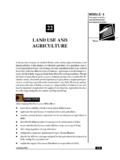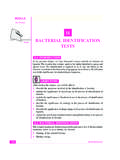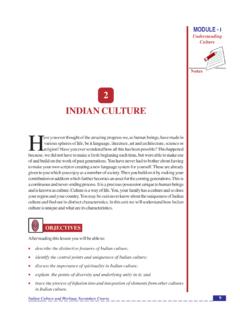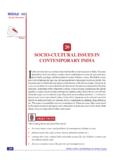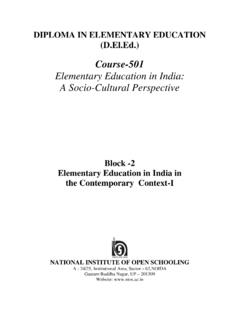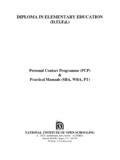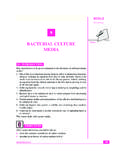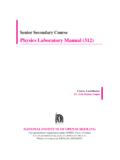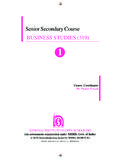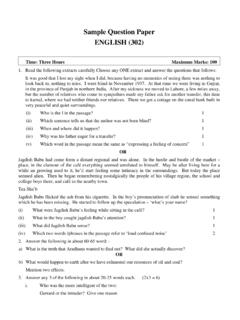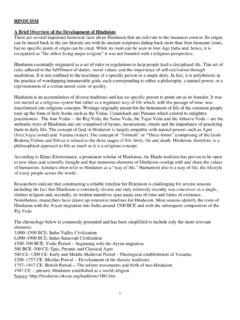Transcription of DOMAINS OF DEVELOPMENT - National Institute of Open …
1 89 DOMAINS of DevelopmentEARLY CHILDHOOD CARE AND EDUCATIONN otes7 DOMAINS OF DEVELOPMENTD evelopment of children is a complex and a continuous process. It takes placein many areas or DOMAINS which together influences their holistic the previous lesson, you have learnt about growth and DEVELOPMENT of childrenand the principles of DEVELOPMENT . In this lesson, you will study in details thedifferent DOMAINS of DEVELOPMENT namely, physical and motor, socio- emotional, moral , cognitive and language DOMAINS of DevelopmentLEARNING OUTCOMESA fter studying this lesson, you will be able to: discuss the features of each of the many DOMAINS of DEVELOPMENT ; and discuss the significance of developmental andMotorMoralCognitiveLanguageSocio-Emot ionalEARLY CHILDHOOD CARE AND EDUCATIOND omains of DEVELOPMENT DOMAINS OF DEVELOPMENTD omains of DEVELOPMENT refer to different areas or aspects in which children s developmenttakes place.
2 The various DOMAINS of DEVELOPMENT and motor DEVELOPMENT including gross and fine motor Socio-emotional DEVELOPMENT refers to an understanding of self and the socialenvironment, managing and expressing emotions in a socially desirable moral DEVELOPMENT refers to the sense of right and Cognitive DEVELOPMENT refers to thinking and understanding of variousconcepts and Language DEVELOPMENT , communication, emergent and early literacy focusingon listening, comprehension, oral/speaking skills and us study about each of these DOMAINS of DEVELOPMENT in Physical and Motor DevelopmentPhysical growth and DEVELOPMENT includes increase in height, weight and changesin the proportions of the body structure. It includes the DEVELOPMENT of entire structure of the body depends on the bones, on their size, proportionand density. They give an overall configuration and look to the body.
3 You haveread in the previous lesson that physical DEVELOPMENT takes place in two ways,proximodistal and cephalocaudal. Physical DEVELOPMENT includes not only changeshappening externally but also what happens internally in the body. It also includeschanges and maturation of internal organs. As children grow physically, the internalorgans including the brain and the central nervous system also DEVELOPMENT can be understood better in terms of fine and gross motorskills. Motor skills are physical abilities that children develop, which help themcontrol the movements of their bodies. In a relatively short period of time, theybegin to develop simple motor develop two broad kinds of motor skills gross motor skills and finemotor skills. Gross motor skills involve large muscles and help control actionsof children such as crawling, standing, walking, climbing, running and so motor skills involves mall muscles and affects the ability to use hands andfingers effectively.
4 Fine-motor skill DEVELOPMENT usually involves eye-hand co-ordination, which is the ability to match the movements of the hands with whatthe eyes see. Developing fine motor skills help children in holding things like acup or a crayon, turning the pages of a book, buttoning and zipping, drawing andwriting, etc. In simple words, fine motor skills help children grasp, hold, moveand handle different objects. Most of the activities of children, as well as ours,require a combination of gross and fine motor skills. 91 DOMAINS of DevelopmentEARLY CHILDHOOD CARE AND EDUCATIONN otesPhysical DEVELOPMENT takes placecontinuously throughout our entire , the nature and rate of growth mayvary depending upon the stage ofdevelopment. Every child develops at her/his own pace. Some children grow fasterwhile some are not that fast but it does notmean that they are physically immature orless developed.
5 Every child is different,therefore, individual differences can be seenamong children sharing similar genomes andenvironmental conditions. In addition tothat, gender differences in physical DEVELOPMENT can also be QUESTIONS (a)What is meant by gross and fine motor skills?(b) Suggest two activities that parents can organise at home to promote grossand fine mot or DEVELOPMENT of their Socio-Emotional DevelopmentDo you talk to a child and an adult differently? Do you talk to your teacher andyour friend differently? How did you learn to behave differently with differentpeople, depending upon your relationship with that person? Do you behavesimilarly in all situations or do you behave differently in different situations?When children enter this complex world, they do not know any rules andregulations of society. They gradually learn to interact with others, relate withothers and obey social rules.
6 How we relate to others in different social situationsand learn to act according to the established social rules and regulations of societycomes under social DEVELOPMENT . It also includes participation and involvementin social activities and understanding the meaning of being part of social child is a social being and needs to connect with people around for a DEVELOPMENT refers to the DEVELOPMENT of emotions and feelings inchildren. Some emotions such as happiness, fear and anger can be termed asbasic emotions as they can be inferred directly from a person s facial emotions such as shame, guilt and envy can be classified as complexemotions as they cannot be simply inferred from facial expressions. Children areborn with basic emotions and they develop complex emotions DEVELOPMENT ofFine Motor SkillsEARLY CHILDHOOD CARE AND EDUCATIOND omains of DEVELOPMENT 92 NotesHave you experienced any changes in the way you express the followingemotions?
7 Please write the :..Fear: ..Sadness:..Do you recall how you used to show your love or anger towards your parentswhen you were five years old ? How do you express the same feelings now? Canyou notice any transition in expressing the same emotions towards your parents?This brings us to the point that expression of emotions and behaviours related tothem evolve over time. Some of these changes may be a result of our ownemotional maturity and exposure to the differences in the expression of emotions may also exist as each cultureteaches its children to show their emotions in a different manner. Genderdifferences in expression of different emotions might also Socio-emotional DEVELOPMENT at different stageszInfancyInfants interact with people around them by smiling, crying, babbling and these initiate and sustain the infant s interaction with others.
8 When an infantreceives positive response and stimulation from others in the environment, s/he isencouraged to develop socially. By the age of six to eight months, infants learnto develop a sense of belongingness and begin to develop attachment with parentsand other familiar persons in their world. It is seen that infants feel stranger anxiety, , fear of being separated from their primary caregiver when they complete thefirst year of their life. This anxiety decreases gradually and children develop specialattachments. By the age of two years, children begin to detach a little from theirparents and learn to show autonomy by saying no to what they do not want ChildhoodChildren develop self-awareness by the age of two to five years. They developattitudes, likes and dislikes and ways of acting. Socialisation is the process bywhich children acquire skills to become responsible adults in their are socialised primarily by parents who make children understand and 93 DOMAINS of DevelopmentEARLY CHILDHOOD CARE AND EDUCATIONN otesrealise the difference between right and wrong and help in developing a code ofconduct in them.
9 A strong identification process helps in socialisation as childrenobserve and imitate their parents who become role models for their social world of preschool children expands and includes their peer group inschool and in the neighbourhood. They begin to engage in cooperative play andgames with them. These provide a ground to relate with others and understandsocial situations better. They also begin to develop a psychological identity asmembers of either one or the other gender and insist on following genderappropriate behaviour. Gender role identity arises from a number of factors-frombiological differences between the sexes and from the way parents and otherssocialise boys and QUESTIONS as many words as you can related to emotions in the following grid:W XYZ J EALOUS YKL MA BCDOFSHOCKNNOPH APP YOUQHOP E S YFO B AN GE RRL T P R I D EP WI HJ UPSE T KVMBAE O NS YCRAG E P O L Y RF RDF GHI NOKT US Z OU RHJ BDSADOBS KJ CL YFLOVEQZTUWVBAS CAREDFJ RMOKS T LE MBA RRAS S ME N T F moral DevelopmentThe word moral has been taken from the word mores which means manners andcustoms.
10 In the simplest terms, it is a sense of right and wrong. It includes moralbehaviour, moral reasoning and judgment. moral behavior entails acting in amorally right manner. moral reasoning refers to weighing options as right orwrong. This is based on whether or not we are able to understand multipleperspectives related to the us read about DEVELOPMENT of moral reasoning in DEVELOPMENT of moral reasoning in childrenA number of psychologists have described moral DEVELOPMENT among CHILDHOOD CARE AND EDUCATIOND omains of DEVELOPMENT 94 NotesLet us briefly study the stages of moral DEVELOPMENT as proposed by psychologistsJean Piaget and Lawrence to Piaget, children s moral DEVELOPMENT can be understood by observingtheir understanding of rules during play. He described children moral developmentthrough two stages namely heteronomous and autonomous believe that rules are universal, fixed and handeddown by any external authority.
